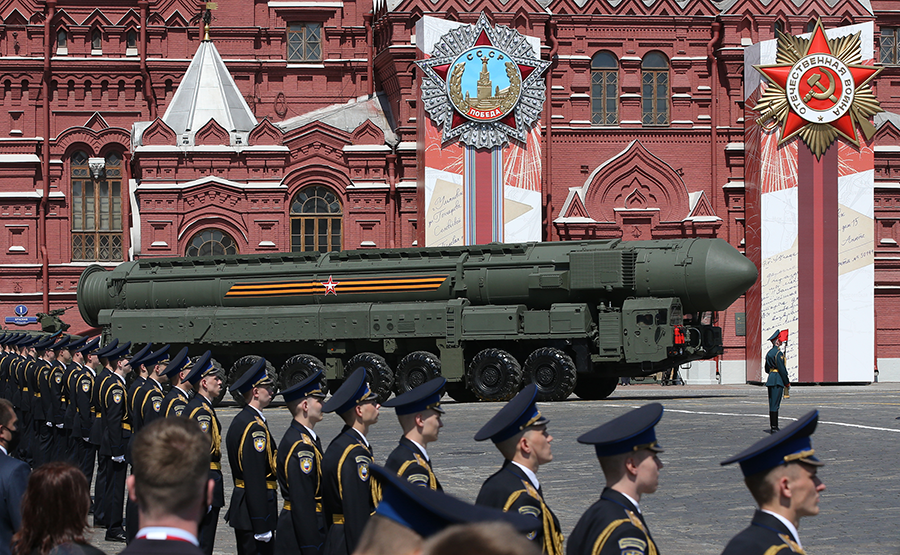Countering Nuclear Extremism With Prudent Restraint
June 2023
By Daryl G. Kimball
The decades-long effort to halt and reverse an arms race involving the world’s deadliest weapons may soon number among the casualties of Russian President Vladimir Putin’s unprovoked invasion of independent, non-nuclear Ukraine and his increasingly reckless nuclear threats.
 Over the apparent objections of his own foreign ministry and defense advisers, Putin announced in February that Russia will “suspend” implementation of the last remaining bilateral treaty capping U.S. and Russian strategic nuclear arsenals, the 2010 New Strategic Arms Reduction Treaty (New START). The Russian Foreign Ministry blamed the United States for undermining talks to resolve differences over New START with its “hostile policy towards Russia.”
Over the apparent objections of his own foreign ministry and defense advisers, Putin announced in February that Russia will “suspend” implementation of the last remaining bilateral treaty capping U.S. and Russian strategic nuclear arsenals, the 2010 New Strategic Arms Reduction Treaty (New START). The Russian Foreign Ministry blamed the United States for undermining talks to resolve differences over New START with its “hostile policy towards Russia.”
Russia will no longer share detailed data on its nuclear stockpile or allow the resumption of on-site inspections, but the Kremlin says it will comply with the central limits of New START, which is set to expire in less than three years. If the two sides fail to negotiate new arrangements to supersede or succeed the treaty, there will be no limits on the world’s two largest nuclear arsenals for the first time since 1972.
Without New START, which restricts each side to no more than 1,550 strategic warheads deployed on 700 delivery vehicles, Moscow and Washington could quickly double the size of their nuclear arsenals by uploading additional warheads on ballistic missiles.
U.S. President Joe Biden has made it clear consistently that his administration stands “ready to expeditiously negotiate a new arms control framework to replace New START when it expires in 2026. But negotiation requires a willing partner operating in good faith.”
The United States, its allies, and many other states have strongly condemned Putin’s suspension of New START and called on Russia to change course. At its summit in May, the Group of Seven industrialized countries declared that “[t]he overall decline in global nuclear arsenals achieved since the end of the Cold War must continue” and called on Russia to engage in substantive discussions in line with its nuclear Nonproliferation Treaty (NPT) disarmament obligations.
As with Russia, the United States has its own contingent of nuclear weapons extremists. In mid-May, a loud group in Congress, led by Sen. Tom Cotton (R-Ark.), introduced legislation that calls for the United States to withdraw from New START, increase the size of its already massive nuclear arsenal, and would only allow a future treaty with Russia if it restricts all types of nuclear warheads and if China is included.
Such action to stop implementation of New START or to withdraw from the treaty entirely would neither advance U.S. interests nor increase U.S. negotiating leverage vis-à-vis Russia. Rather, it would lend credence to Putin’s cynical disinformation campaign about who carries blame for the breakdown of nuclear arms control, further escalate already high tensions with a dangerous Russia, undoubtedly encourage China to ramp up its efforts to expand and diversify its nuclear arsenal; and undermine the security of U.S. allies in Europe and Asia. It might even trigger the unraveling of the NPT itself.
Cotton is among those who seem to believe that, in order to deter a Russian or Chinese nuclear attack, the United States must grow its nuclear arsenal to a size greater than the combined Russian and Chinese arsenals. But he is wrong.
First of all, the size and diversity of the current U.S. nuclear arsenal still exceeds in number and in destructive capability what is necessary to hold a sufficient number of adversary military assets at risk so as to deter an enemy nuclear attack. Fielding even more nuclear weapons will not produce a more stable balance of nuclear terror.
In addition, as U.S. Defense Secretary Lloyd Austin noted in December, “[N]uclear deterrence isn’t just a numbers game. In fact, that sort of thinking can spur a dangerous arms race.” After all, as history shows, arms races are very costly and very dangerous and do not produce any winners.
Rather than take dangerous actions that accelerate dangerous nuclear competition, the United States must exercise prudent nuclear restraint. Most importantly, the United States could seek an executive agreement or simply a reciprocal unilateral arrangement verified with national technical means of intelligence that commits Russia and the United States to respecting New START’s central limits until a more permanent arms control arrangement is concluded.
At the same time, world leaders should urge China, France, and the United Kingdom to freeze the size of their nuclear arsenals as long as Russia and the United States meet their most fundamental disarmament responsibility, which is to engage in good faith negotiations to halt and reverse the nuclear arms race.
Preventing nuclear arms racing, nuclear proliferation, and nuclear war must be a global endeavor, but there is no substitute for commonsense U.S. leadership to reduce the nuclear danger.
